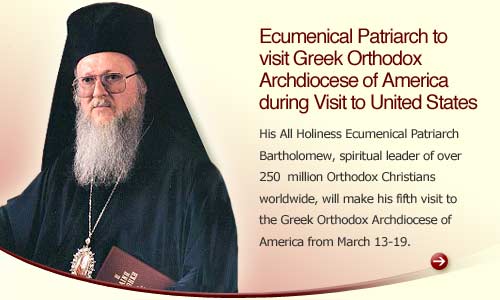Speech of His All Holiness Ecumenical Patriarch Bartholomew at the dinner of the Exhibit "Byzantium: Faith and Power" (1261-1557) at the Metropolitan Museum of Fine Arts (March 15, 2004)
Your Eminence, Archbishop Demetrios of America, beloved brother in Christ,
Most erudite Director of the Metropolitan Museum of Art,
Most honorable and beloved friends of art and sponsors of this exhibit,
It is with feelings of great joy and deep emotion that we take part in the inaugural ceremony and dinner of this exhibit, which unveils select works of art from the last period of the Byzantine Empire, namely, from the period between the years 1261 and 1557.
We wholeheartedly congratulate the parties who took the initiative to make this exhibition a reality, namely, AlphaBank and the three very important Greek Foundations of Costopoulos, Levendis, and Niarchos, for their sponsorship. This exhibition is the third one in a row, following two other exhibitions that took place in the recent past and that had a similar theme. We also want to congratulate the organizers, sponsors, and all who labored for the gathering, transportation, successful display, and secure protection of the exhibition articles originating from many countries.
The title of the exhibit brings the idea of material might to our mind, which is a most needed tool for the maintenance of an empire, like the Byzantine Empire. In this case, though, these articles come from a period of time during which the Empire was not at its mightiest. Thus, one’s attention should be aimed at the spiritual power instead, which was kept intact in spite of all the destruction that Crusaders had inflicted upon the Empire. It is precisely this spiritual power that created the dazzling artifacts displayed in this exhibit.
It has been historically observed that when empires lived in times of political decline, the arts that had been cultivated within these empires did not necessarily follow the same declining course; these, instead, could be flourishing. This phenomenon is attributed to the fact that the tradition of culture extends beyond any material destruction.
The period in which these works of art were created is not considered to be one of the shiniest, according to worldly evaluations. It is thought of, though, as one of the most productive and creative as far as spiritual accomplishments are concerned. Spiritual power continued to be vigorous the same way that faith was vigorous. The cultured Byzantine man had reached the peak of his capabilities, receiving reinforcement by his robust faith. The power that derives from faith, and the spiritual accomplishments that this power enables, are preserved for centuries, whereas material might becomes the object of envy and fatefully ends up in the hands of the strongest. The material means that the Spirit needs in order to create its works are but a few; the needs of an empire to sustain itself, though, are multiple and hard to find.
The world of Byzantium was characterized by an element that is not as widespread in our era. Here, we refer to the element of Christian faith. Today, what rather prevail are secularism and the great emphasis that is attributed to material power and its ensuing results in very many areas. Byzantine Civilization and its works, which are so very different than ours, are ones for us to focus our attention upon.
The Ecumenical Patriarchate constitutes the living continuation of Byzantine Civilization and feels a particular joy upon realizing that you have, for a long time, been concerned about the history of its existence. We believe that the modern world has a great need to acquire the faith of the Byzantine people. Their faith is worthy of our acceptance not because of all the remarkable artistic artifacts that the period of the Empire had yielded, but because it has given salvaging answers to questions that relate to metaphysical quests.
The human being of today, particularly the one who lives in the most economically and culturally developed areas of the world, faces a detrimental enemy, namely, the lack of meaning of life. The abundance of material goods does not fill the heart of today’s human being with the type of assurance which nests within the poor but faithful man’s heart.
Therefore, the meaning of faith, which is opportunely projected by the name of this exhibit, constitutes a great need for all. Moreover, the material power that one finds in excess in today’s world cannot substitute for the lack of faith. The only true power is spiritual power, and true faith is its only supporter.
May the works in this exhibit lead us to the right path of true faith from which true spiritual power derives. This spiritual power, in turn, is the creative power behind these displayed works of art. Most importantly, it is the creative power behind works of life that are less glamorous, but nevertheless are works that produce love for one another, joy and hope in life.
We wholeheartedly pray for the success of this exhibit, and we will consider as a great accomplishment, the true realization of the message conveyed through its title, in its true dimension: Faith and Power. Amen.


